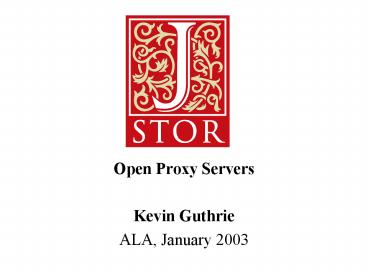Open Proxy Servers - PowerPoint PPT Presentation
1 / 27
Title:
Open Proxy Servers
Description:
... Proxy #2 at a different participating site. ... 27 open proxy servers at. 16 different sites. As JSTOR staff denied each proxy server, the abuse moved on. ... – PowerPoint PPT presentation
Number of Views:117
Avg rating:3.0/5.0
Title: Open Proxy Servers
1
- Open Proxy Servers
- Kevin Guthrie
- ALA, January 2003
2
Outline
- Background what are open proxies?
- Whats the exposure?
- What happened?
- How was it done?
- Not an isolated case
- What to do
3
What has been taken51,392 Articles from 11
Titles
4
Proxy Servers
- A proxy server is a web server that acts as an
intermediary or relay station between a
workstation user and the Internet.
5
(No Transcript)
6
Proxy Servers Common Reasons for Their Use
- Caching
- Remote access
- Usage tracking
- Controlled access
- Approved filtering
7
What is an open proxy server?
- There is a configuration process to specify who
is authorized to access the server. It is
similar to the configuration process for any web
server - When a proxy server is not set up with the
appropriate access controls, anyone can access
that machine and assume its identity
8
Open Proxy ServersHow and Why are they Created
- Some are organizational or departmental proxy
servers incorrectly configured. - Some are set up intentionally to provide access
to restricted resources (probably for
convenience). - We believe many are set up accidentally as an
unknown by-product of setting up a web server.
9
Whats the Exposure?
10
Search For Lists of Open Proxy Servers
11
Find Lists of Open Proxy Servers
12
Lists of Open Proxy Servers by Domain Type
13
A List of Open .edu Proxies
The server hostnames have been edited to protect
the institutions with open proxy servers listed
on this page.
14
What Happened and How it was Discovered
15
JSTOR Monitors Use
- We have triggers to alert us to unusual levels of
usage activity - We investigate when usage seems unusual
16
The Abuse What Happened
- August 22nd to the 27th -- 13413 articles are
downloaded from Proxy 1. - August 27th we deny this IP access to JSTOR.
- --------------------------------------------------
----------- - August 26th to September 4th -- 3859 articles are
downloaded from Proxy 2 at a different
participating site. - September 4th we deny the IP address of this
second proxy.
17
The AbuseWhat Happened
- It appeared the two abuse situations were
related - There was an overlap in journals downloaded, but
not an overlap in articles downloaded. - Analysis of our log files showed that the URLs
being downloaded via Proxy 2 were created
through use at Proxy 1.
18
The AbuseThe Pattern Continues
- Between August 27th and October 31st downloads
occurred from - 27 open proxy servers at
- 16 different sites
- As JSTOR staff denied each proxy server, the
abuse moved on.
51,000 articles downloaded from 11 journals
19
How Is It Done?
20
Automate The Process
- Download lists of open proxies
- Automate a process to probe each to see if there
is access to restricted resources - Identify a set of open proxy servers with such
access and set them aside - Automate a process to download content
- From the confirmed list commence downloading.
21
Not an Isolated Case
- We have found web pages providing explicit
instructions for others to help them exploit open
proxies in order to download content.
22
Not an Isolated Case
23
Not an Isolated Case - Translations
- The Bible for Downloading Journal Articles
- To be blunt about it, you find an overseas
proxy. The institution that the proxy server
belongs to has spent money to buy the electronic
edition of some journal, and then you use this
proxy, (so) of course you can download the entire
text of that journal! - I cannot deny that some servers can download
complete texts from many journals, but please,
everyone, lets not grab onto the ones which are
easy to use and use them madly. The result of
doing so will be to hasten the death of that
server! So when you are using them, its best to
do so equitably!
24
Not an Isolated Case
25
Questions Discussion
26
What to do?
- Shibboleth
- http//shibboleth.internet2.edu/
- DLF Certificates
- http//www.diglib.org/architectures/digcert.htm
- Education
- Drive all campus access through a set of properly
authenticated proxy servers
27
http//www.jstor.org/































